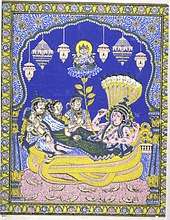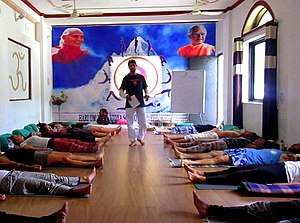Yoga nidra
Yoga nidra (Sanskrit: योग निद्रा) or yogic sleep is a state of consciousness between waking and sleeping, like the "going-to-sleep" stage, typically induced by a guided meditation.
There is evidence that yoga nidra helps relieve stress. An ancient technique from India, it has now spread worldwide and is also being applied by the US Army to assist soldiers to recover from post-traumatic stress disorder.
State of consciousness
Yoga nidra is a state in which the body is completely relaxed, and the practitioner becomes systematically and increasingly aware of the inner world by following a set of verbal instructions.[1][2] This state of consciousness is different from meditation, in which concentration on a single focus is required.[1] In yoga nidra the practitioner remains in a state of light withdrawal of the 5 senses (pratyahara) with four senses internalised, that is, withdrawn, and only hearing still connects to any instructions given.[1] The goals of both yogic paths, yoga nidra and meditation are the same, a state of meditative consciousness called samadhi.[3]
It is among the deepest possible states of relaxation while still maintaining full consciousness. In lucid dreaming, one is only, or mainly, cognizant of the dream environment, and has little or no awareness of one's actual environment.[4]
Yoga nidra results in conscious awareness of the deep sleep state, which is called prajna in the Mandukya Upanishad.[5]
History

It is said that the history of yoga nidra is as old as yoga itself, as the first mention of yoga nidra is in the Upanishads.[2] Lord Krishna is associated with yoga nidra in the epic Mahabharata:[6]
[The Ocean] becomes the bed of the lotus-naveled Vishnu when at the termination of every Yuga that deity of immeasurable power enjoys yoga-nidra, the deep sleep under the spell of spiritual meditation.
— Mahabharata, Book 1, section XXI
Modern usage
In modern times, Satyananda Saraswati claimed to have experienced yoga nidra when he was living with his guru Sivananda Saraswati in Rishikesh. He began studying the tantric scriptures and, after practice, constructed a system of relaxation which he popularized in the mid-20th century. He explained yoga nidra as a state of mind between wakefulness and sleep that opened deep phases of the mind, suggesting a connection with the ancient tantric practice called nyasa, whereby Sanskrit mantras are mentally placed within specific body parts, while meditating on each part (of the bodymind). The form of practice taught by Satyananda includes eight stages (internalisation, sankalpa, rotation of consciousness, breath awareness, manifestation of opposites, creative visualization, sankalpa and externalisation). Satyananda used this technique, along with suggestion, on the child who was to become his successor, Niranjanananda Saraswati, from the age of four. He claims to have taught him several languages by this method.[7]
The Mindful Yoga teacher Anne Cushman states that "This body-sensing journey [that I teach in Mindful Yoga] ... is one variation of the ancient practice of Yoga nidra ... and of the body-scan technique commonly used in the Buddhist Vipassana tradition."[8]
The western pioneer of yoga as therapy, Richard Miller, has developed the use of Yoga nidra for rehabilitating soldiers in pain, using the Integrative Restoration (iRest) methodology.[9] Miller worked with Walter Reed Army Medical Center and the United States Department of Defense studying the efficacy of the approach.[10][11] According to Yoga Journal, "Miller is responsible for bringing the practice to a remarkable variety of nontraditional settings" which includes "military bases and in veterans' clinics, homeless shelters, Montessori schools, Head Start programs, hospitals, hospices, chemical dependency centers, and jails."[12] The iRest protocol was used with soldiers returning from Iraq and Afghanistan suffering from post-traumatic stress disorder (PTSD).[13][14][11] Based on this work, the Surgeon General of the United States Army endorsed Yoga Nidra as a complementary alternative medicine (CAM) for chronic pain in 2010.[15]
Scientific evidence
Yoga nidra meditation is associated with increased endogenous dopamine release in the ventral striatum of the brain.[16] The reduced desire for action in the state is associated with the reduced flow of blood in parts of the brain connected with controlling actions, the prefrontal cortex, the cerebellum and the subcortex.[16]
Yoga nidra improves heart rate variability, a measure of balance in the autonomic nervous system, whether or not it is preceded by a session of hatha yoga asanas.[17]
The regular practice of yoga relaxation has been found to reduce tension and anxiety. The autonomic symptoms of high anxiety such as headache, giddiness, chest pain, palpitations, sweating and abdominal pain respond well. It has been used to help soldiers from war cope with posttraumatic stress disorder (PTSD).[18] A 2019 study suggests that yoga nidra can alleviate stress and improve self-esteem of university students.[19]
See also
- Dream yoga
- Yoganidrasana, the asana named for Yoga Nidra
References
- Ross, Gillian (23 July 2009). "Yoga nidra: deep relaxation practice". ABC. Archived from the original on 29 July 2009. Retrieved 12 April 2019.
- Desai, Kamini (2017). Yoga Nidra The Art of Transformational Sleep. Twin Lakes USA: Lotus Press. p. 689. ISBN 978-1-6086-9213-2.
- "The Theory and Principles of Yoga Nidra". Spirit Web. Retrieved 12 April 2019.
- "Lucid Sleeping (Yoga Nidra) - Meditation Mojo". www.meditationmojo.com.
- Rama, Swami (1982). Mandukya Upanishad: Enlightenment Without God. ISBN 978-0-89389-084-1.
- "Mahabharata Book 1 Section XXI". Sacred Texts. Retrieved 12 April 2019.
- Saraswati, Swami Satyananda (1974). Tantra-yoga panorama. International Yoga Fellowship Movement. p. 25.
- Cushman 2014, pp. 44–45.
- Miller, Rick (2005). Yoga Nidra : the meditative heart of yoga. Boulder, Colorado: Sounds True. ISBN 978-1-59179-379-3. OCLC 62705943.
- "Yoga-based Treatments Beat Stress" (PDF). Let's Talk (Winter 2010): 1–2. 2010. Archived from the original (PDF) on May 28, 2010.
As a natural alternative to medication, yoga offers tools that mitigate stress and improve quality of life. It can also have a positive effect on blood pressure and heart rate. Practicing yoga postures increase relaxation while the inward focus and meditation enhances calm. Yoga's favorable track record prompted the Department of Defense (DoD) to first pilot, and then adopt a yoga-based Post-traumatic Stress Disorder (PTSD) reduction program utilizing a form of Yoga Nidra. The program, called iRest (Integrative Restoration), utilizes yoga, progressive relaxation, and meditation to manage negative emotions and stress. The iRest program has helped veterans reduce PTSD symptoms, anxiety, and insomnia. There are now iRest programs at Veterans Health Administration (VA) facilities in Miami, Chicago, and Walter Reed Army Medical Center in Washington, D.C. as well as active duty facilities nationwide.
- https://www.apa.org/monitor/2009/11/yoga.aspx
- "The Benefits of Yoga Nidra". Retrieved 19 August 2018.
- Major (Dr.) Nisha Money (2009). "Yoga Nidra (iRest): A "New Twist" on Treatment for Post Traumatic Stress Disorder (Part I)" (PDF). 5 (4 Winter 2009): 12–13. Archived from the original (PDF) on July 19, 2011. Retrieved 2010-12-22.
The iRest military program, based on the ancient practice of Yoga Nidra, is designed to systematically reduce physical, emotional, mental, and even subconscious tension that characterizes PTSD. Participants are taught to manage disturbing moods and memories with a skill set that enables them to objectively respond to intense emotional experiences through conscious choices rather than unconscious reactions.
Cite journal requires|journal=(help) - "Walter Reed Using Yoga to Fight PTSD | Danger Room". Wired.com. 2008-05-06. Retrieved 2010-12-22.
- "Pain Management Task Force | Providing a Standardized DoD and VHA Vision and Approach to Pain Management to Optimize the Care for Warriors and their Families | Final Report" (PDF). Office of the Army Surgeon General. May 2010. Retrieved 12 April 2019.
[extract from table in Figure 11: Tier I Modalities] Modality: Yoga / Yoga Nidra; Passive: Facility based yoga classes; Active: Self directed with video, exercising
- Kjaer, Troels W; Bertelsen, Camilla; Piccini, Paola; Brooks, David; Alving, Jørgen; Lou, Hans C (2002). "Increased dopamine tone during meditation-induced change of consciousness". Cognitive Brain Research. 13 (2): 255–259. doi:10.1016/s0926-6410(01)00106-9. PMID 11958969.
- Markil, Nina; Whitehurst, Michael; Jacobs, Patrick L.; Zoeller, Robert F. (2012). "Yoga Nidra Relaxation Increases Heart Rate Variability and is Unaffected by a Prior Bout of Hatha Yoga". The Journal of Alternative and Complementary Medicine. 18 (10): 953–958. doi:10.1089/acm.2011.0331. PMID 22866996.
- Rivers, Eileen. A Breath of Hope. Washington Post Tuesday, May 6, 2008; Page HE01. https://www.washingtonpost.com/wp-dyn/content/article/2008/05/02/AR2008050203426.html
- Dol, Kim Sang (May 2019). "Effects of a yoga nidra on the life stress and self-esteem in university students". Complementary Therapies in Clinical Practice. 35: 232–236. doi:10.1016/j.ctcp.2019.03.004. ISSN 1873-6947. PMID 31003664.
Sources
Cushman, Anne (2014). Moving into Meditation: A 12-Week Mindfulness Program for Yoga Practitioners. Shambhala. ISBN 978-1611800982.CS1 maint: ref=harv (link)
External links
- Systematic review articles on Yoga Nidra indexed by Google Scholar
- How to Learn Yoga Nidra in very Easy Way (by Yoga Nidra Expert)
- https://itunes.apple.com/app/id430531216?mt=8

